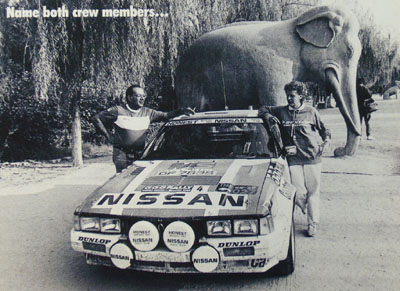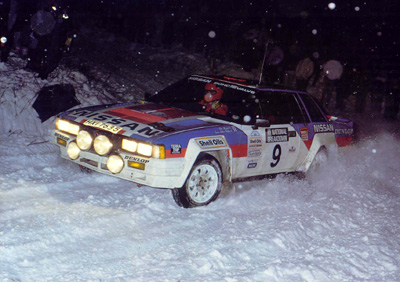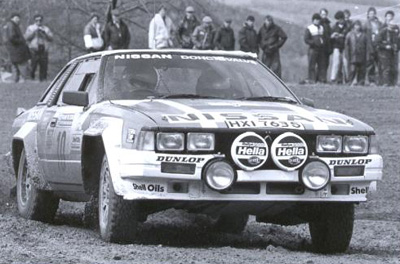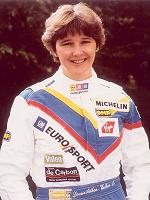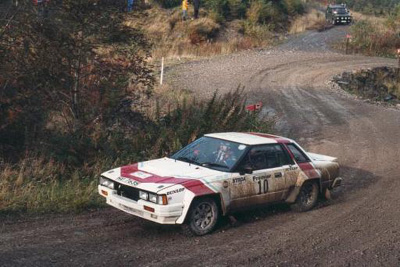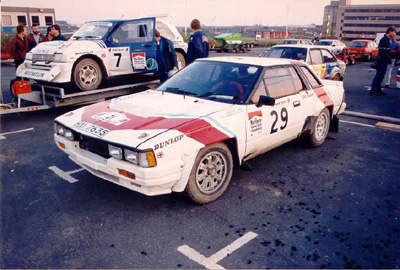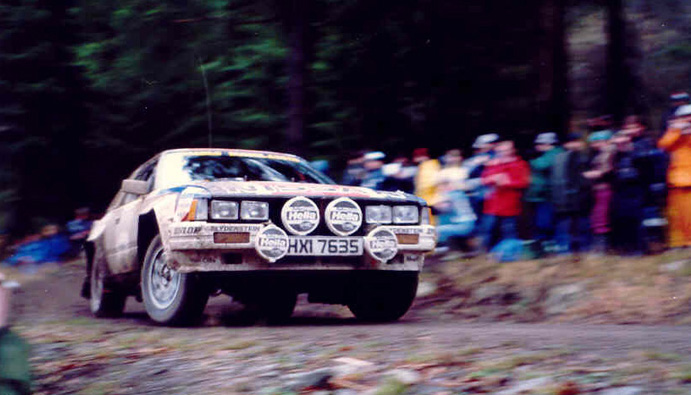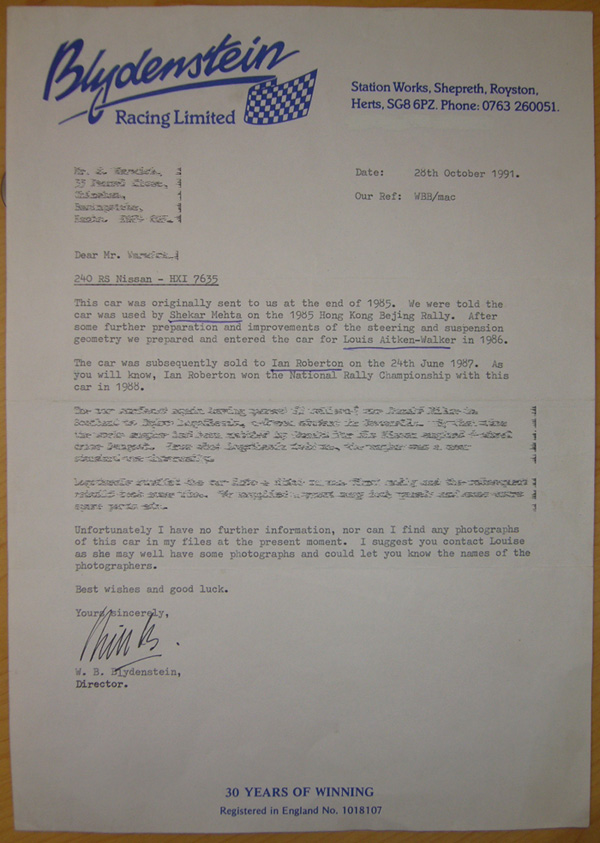|
Team Nissan Europe and the Nissan 240RS
Bill
Blydenstein Racing (BBR) was a company based at the old railway station at
Shepreth, nr Cambridge in the 1970's and '80’s. They had a
fantastic reputation as a Rally Team having run the “Dealer Team Vauxhall” Rally Team since the mid 1970's, developing the
Vauxhall Chevette HS & HSR into extremely competitive rally cars for
General Motors.
Due to General
Motors' marketing shift towards Opel instead of Vauxhall BBR would lose the
Vauxhall contract at the end of 1982.
With the aid of
driver Tony Pond, Bill Blydenstein negociated a deal with Nissan to run the
Nissan 240RS in Europe for the 1983 season.
Little did he
know that over the next three years he would struggle with constant under – budgeting to develop the car and
the speed in which Group B competition grew.
From April 1984
BBR negociated a contract with Nissan to market and sell the 240RS worldwide
except in the USA and Japan.
BBR imported cars into Northern Ireland and registered them there.
This was a loop
hole that allowed them to bring the cars into England whilst avoiding type
approval issues.
BBR offered the cars for sale in a straight from the factory road car
specification at £12,500.
This consisted of a right or left hand drive car with a 220bhp wet sumped
engine, front and rear vinyl seats, rally homologated suspension, transmission
and disc brakes all round.
This was in no way a rally car but the basis to build one.
Blydenstein
offered a Clubmans Group B car for £15,515 which had basic safety
equipment fitted including an FIA roll cage and sumpguard. Modified camshafts lifted power to 235bhp but the
engine remained wet sumped.
For £24,990 BBR
would seam-weld, strenghen and install the necessary equipment to bring a car
up to “works replica” forest spec whilst £26,240 would buy you an all singing and dancing tarmac car with approximately
260bhp.
The only
governing factor being the depths of your pockets ! In 1984 BBR sold 42 cars
and over the whole Group B period sold approximately 70 plus cars.
Below is a period advert from November 1984.
From 1983 onwards BBR was constantly improving the car in areas of priority
within the budget Nissan gave them to work to.
The first challenge BBR faced was removing a flat spot in the FJ24 engine.
BBR looked at the cam shafts from Nissan and re-profiled the exhaust cam,
virtually matching the BBR RE3 cam shaft that they had developed for the
Vauxhall Chevette HSR.
This
effectively removed the flat spot and improved the torque spread.
The next thing
they looked at was suspension.
BBR realised very quickly that the 240RS was blessed with a low centre
of gravity.
This led to BBR
developing spring and damper settings
that allowed more ground clearance for UK forest events.
The combination
of a tough, reliable and well set up car that was affordable to club
competitors meant that many 240RS's appeared in UK and other National Championships in the hands of up and
coming drivers.
The British
National Championships in 1984 and 1985 were won by Dai Llewellin and Mark
Lovell respectively.
By then
Blydenstein realised that his core business was now at club level and to make
the cars more attractive to competitors on a tight budget he began sourcing
non-Nissan replacement parts in the UK.
These included
items such as fuel tanks, sumpguards, suspension parts etc.
By 1985 Group B
cars such as Peugeot's 205 T16 and Lancia's Delta S4 made Nissan's 240RS and other cars like it uncompetitive in the World and European
Championship's.
This aside, up until the end of Group B in 1986, the Nissan could still
put in a strong performance in the right hands.
In 1985 Nissan
homologated a steering rack to replace the original troublesome steering
boxes and also homologated brakes,
gearbox and other items to improve performance.
In 1986 in the British Open Championship, a
hotly contested series, both Louise Aitken-Walker and Simon Davison achieved
top ten finishes on virtually all rounds.
Unfortunately
for most Group B machines the ban at the end of 1986 meant retirement or
destruction in RallyCross events but due to the 240RS being normally aspirated
and conventional in set up it continued to be competitive in the UK and Middle
East Championships.
Ian Roberton
won the 1988 British National Championship in Louise Aitken-Walker's 1986
Championship car.
Sadly though
over these years in lower levels of the sport people who bought 240RS's bought a car which was not on general sale in the UK.
This meant that
any heavy damage to the shell was expensive to repair and consequently the
remaining value in the vehicle was in the engine and transmission.
I suspect that many cars have been destroyed
due to this and certainly in the UK in the late eighties and into the nineties
240RS engines powered a a number of
rear wheel drive Peugeot 205's, Ford Escort's, a Toyota Starlet and even
a Metro 6R4 !
|
